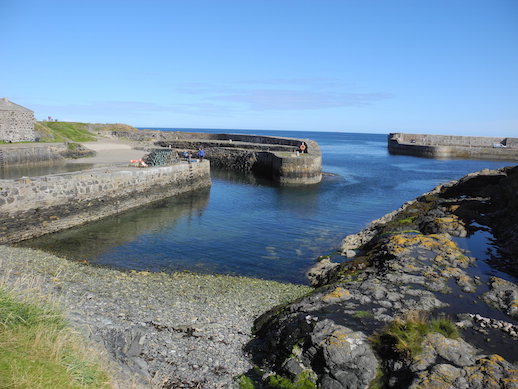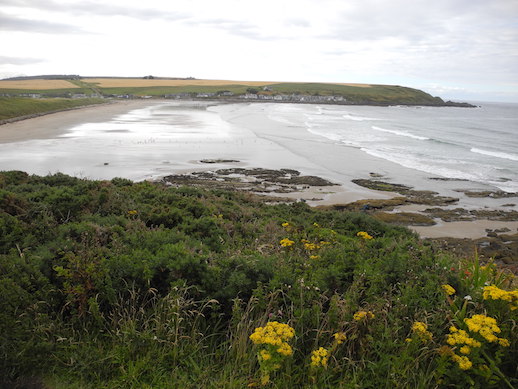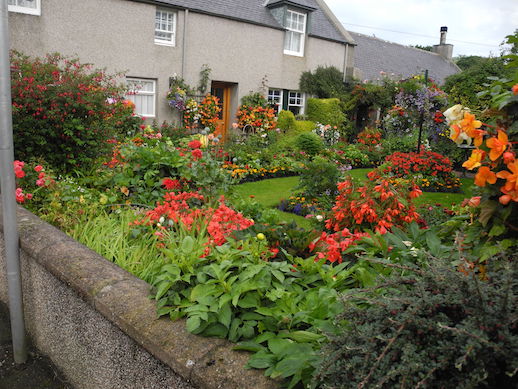 Portsoy Harbour. Photos by Sarah Campbell
Portsoy Harbour. Photos by Sarah Campbell
Words: Luke Slater
A combination of things has brought me to the Banffshire coastal town of Portsoy: curiosity, a holiday and a chance to do a bit of digging around my family history, something which has become a minor hobby in recent months.
Portsoy has a picture postcard quality without being truly beautiful. Side streets wind steeply downhill towards two harbours. The first of these was built in the 17th century, the latter in the 18th, as a result of the boom in herring fishing. In this mizzling weather there is a sense of melancholy about the place, as a solitary man tends stoically to his wooden boat. Later on the wind, rain and late-evening gloom combines with the exposed, rocky coastland to create a sense of something greater and more powerful than beauty.
The rain has not relented by the next morning. We sought refuge in the nearby Salmon Bothy which is, unfortunately, no longer a functioning bothy. The mid-18th century building was refurbished in 2008 and now serves as a museum, community centre and, fortunately, a family history resource. After a quick look at historical fishing paraphernalia, I try to trace my roots a bit further, using recent genealogical discoveries as a starting point.
At the turn of the 20th century, my grandmother’s family (the Hays) moved from the fishing village of Sandend to the Cambridgeshire Fens. The records suggest they were agricultural workers, with occupations such as “pig dealer”, “potato agent” or fisherman written down. The specific reasons for a family moving hundreds of miles have disappeared a long time ago but an educated guess would suggest work. It ties in with the decline of the herring industry at the turn of the century, at least. The Bothy’s resident computer looks to be almost half as old as the building, but it works and I manage to write down a few new (old) names and dates. It seemed promising: James Hay was born in 1782 in Sandend and married Ann Sutherland.
The coastal route from Portsoy to Sandend involves a small initial climb above the harbours. After a hundred or so yards the sight is a fine and panoramic view of the seafront and tall buildings towering over the harbours, in improving weather.
On the edge of town a few locals tend to the gardens of their sea-facing, hilltop cottages as the rainclouds recede inland. A little further out of town the exposed coastal path begins. Grass dotted with heather leads to the steep rocky cliffs and vertical rocky outcrops become more prominent and impressive along the way. Cormorants perch on top of the most distant rocks as whitecaps crash below. The track, which traces the clifftops along the coast, is firm and mostly flat.
Small surprises appear in the opening mile; from a disused open air pool, to a couple of World War II pillboxes, their concrete greyed and mossy yet still accessible. A few of these are used as makeshift bins, littered with coffee cups and sandwich wrappers. Though litter is never a welcome sight, the annoying practice of throwing garbage into anything resembling a cavern is especially dispiriting here.
To the left of the coastal track, lambs emerge energetically from gorse bushes, among fern and thistle. There is a stark juxtaposition of ample arable land stretching for miles and jagged coastline of rocky and green cliffs that mark the land’s end. The path we are on splits the two. It was most likely on this farmland and in these waters that my ancestors worked.
This part of Scotland is not home to the hills and mountains of the West, but has a subtle charm as the features blend into one another. The starkest points are where land meets sea. Looking further inland, swathes of agricultural land slope towards the heathland of Durn Hill. At 199 metres high it pales a little in comparison to the nearby Bin of Cullen (320m) but is visible from most of the local area. It’s a landscape that reminds me slightly of the southern end of my home county, Bedfordshire, albeit with fewer kids flying kites.
Sandend is now in sight, below and ahead. The buildings appear insignificant next to their surroundings; the green and brown hills and fields, the golden sands and the expansive Moray Firth. The Glenglassaugh distillery lies almost directly opposite Redhaven – a small stony cove accessible by a steep and well-trodden grass pathway (which we avoid). Technically a Highland distillery, though not too far from the Spey, it was founded in 1875 before being mothballed in the mid-1980s and re-opened seven years ago. Both old and new warehouses are visible but the most noticeable feature is the mossy ruins of a windmill known as “the cup and saucer”. Sadly its doors are closed for visitors but there is a little left in my hipflask.
Sandend itself is a linear collection of stone cottages along Seaview Road, with a harbour near its end. Like many of these fishing villages, here is a pleasant place with a degree of roughness. Outside the cottages, washing lines hang with drying swimming clothes and wetsuits. There is little to occupy you beyond the beach or the sea, yet benches are strangely plentiful. Given the view, their presence makes sense. Location and not aesthetics is Sandend’s draw, as the surfers may attest.
The choice now is either to retrace our steps or walk uphill and inland, towards Durn Hill. We choose the latter and head for Fordyce, home to a baronial-style castle and, according to the records from the Salmon Bothy, the burial place of some of my ancestors.
We reach Fordyce with the best weather of the day. Unlike Portsoy and Sandend, its colourful and verdant beauty is beyond doubt. The comeliness is almost overwhelming and is amplified by the early-evening sunshine. Durn Hill looms in the background. In Fordyce people take great pride in their gardens, so much so that they host an annual “gardens” open day. The array of plants, trees and shrubs in all manner of public and private spaces alike makes it a village in bloom. Today there is not much life beyond the flora, save for barking dogs, birdsong and a carpenter’s saw.
With little life in sight it seems apt to seek the graveyard. The bell tower juts out, above the stone walls and it marks Fordyce Auld Kirk and its cemetery. I’m barely inside the walls before I see an interesting headstone. It’s a mess of green and brown and the lettering is faded but the inscription is unmistakable. The sun breaks from behind clouds for the first time today to help. It reads:
“ERECTED BY JAMES HAY SANDEND. IN MEMORY OF HIS WIFE ANN SUTHERLAND WHO DIED THE 8TH MARCH 1841 AGED 57 YEARS. ALSO THE ABOVE JAMES HAY WHO DIED AT SANDEND 29TH JANR. 1866 AGED 82 YEARS.”
This should be my “Who Do You Think You Are?” moment. But it isn’t. I try to imagine a life and people – potato agents, fisherman and pig dealers – I have little concept of. There is no mythical sense of belonging. What there is, though, is an overwhelming sense of scale in that distance from here to the Fens, a century ago. In the absence of the whys and wherefores of this emigration, I am happy enough to let this feeling linger a little longer in the evening sun and wonder.

